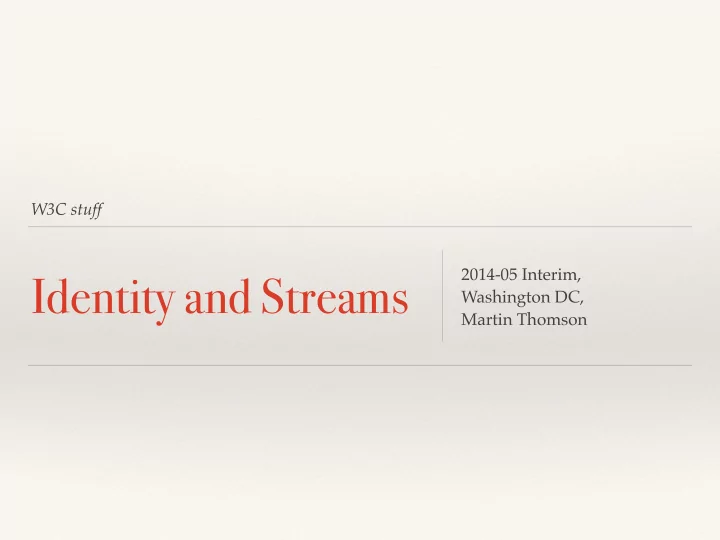

W3C stuff 2014-05 Interim, � Identity and Streams Washington DC, � Martin Thomson
requestIdentity ❖ Reminder: RTCConfiguration parameter with three values: “yes”, “ifconfigured”, “no”. � ❖ Originally included in support of browsers having IdP configuration � ❖ We don’t need this, does anyone else?
Stream Isolation ❖ A receiver should soon be able to distinguish between streams that are isolated at the source and regular streams Sending Receiving peerIdentity Browser Browser isolation too encrypted, � isolated peer authenticated
Isolation Scope ❖ gUM scopes the peerIdentity property to all tracks in the resulting stream � ❖ Tracks can be separated, but they retain the property � ❖ RTCPeerConnection scope is all tracks � ❖ Any isolated track causes a peer to negotiate isolation on all DTLS connections in the PC � ❖ All remote tracks created by that RTCPeerConnection - on both sides - will therefore be isolated � ❖ Alternative: scope to the track or the DTLS connection � ❖ Both create protocol-layer challenges, not recommended
Problem ❖ What do we do when tracks aren’t all isolated? � � ❖ Option 1: fail to create a session � � ❖ Option 2: force all streams on the remote side to become isolated too
Option 1 ❖ Fail if there are both isolated and non-isolated tracks � ❖ A mismatch causes DTLS to fail to negotiate Browser Browser peerIdentity A B not isolated isolated Session failure
Advantages of Option 1 ❖ All or nothing: either all tracks are isolated, or all tracks are not isolated � ❖ Enables authenticated provenance for media based solely on isolation properties � ❖ If media is isolated, we can say that it comes from the authenticated peer and no one else � ❖ Without this, any non-isolated media can’t be identified as such at the receiving end
Additional Proposal for Option 1 ❖ Request that the IETF WG create a marker in the SDP that would allow the API to detect a failure � ❖ …where one side has isolation and the other does not � ❖ If isolation is in the remote SDP and we aren’t isolated, either: � ❖ A) Fail setRemoteDescription (easy) � ❖ B) Check if local streams can be isolated, and isolate them, otherwise, fail setRemoteDescription (bleargh)
Option 2 ❖ Make all tracks isolated if any track is isolated � ❖ A mismatch permits DTLS to negotiate in isolated mode isolated not isolated Browser Browser A B isolated isolated Session created
Advantages of Option 2 ❖ No failures
Isolation Timing ❖ Tracks can be added after establishing a session � ❖ An isolated track, added to a non-isolated RTCPeerConnection MUST send black/silence/null � ❖ Tracks can change isolation properties � ❖ A track that becomes isolated after RTCPeerConnection is opened MUST send black/silence/null
Recommend
More recommend